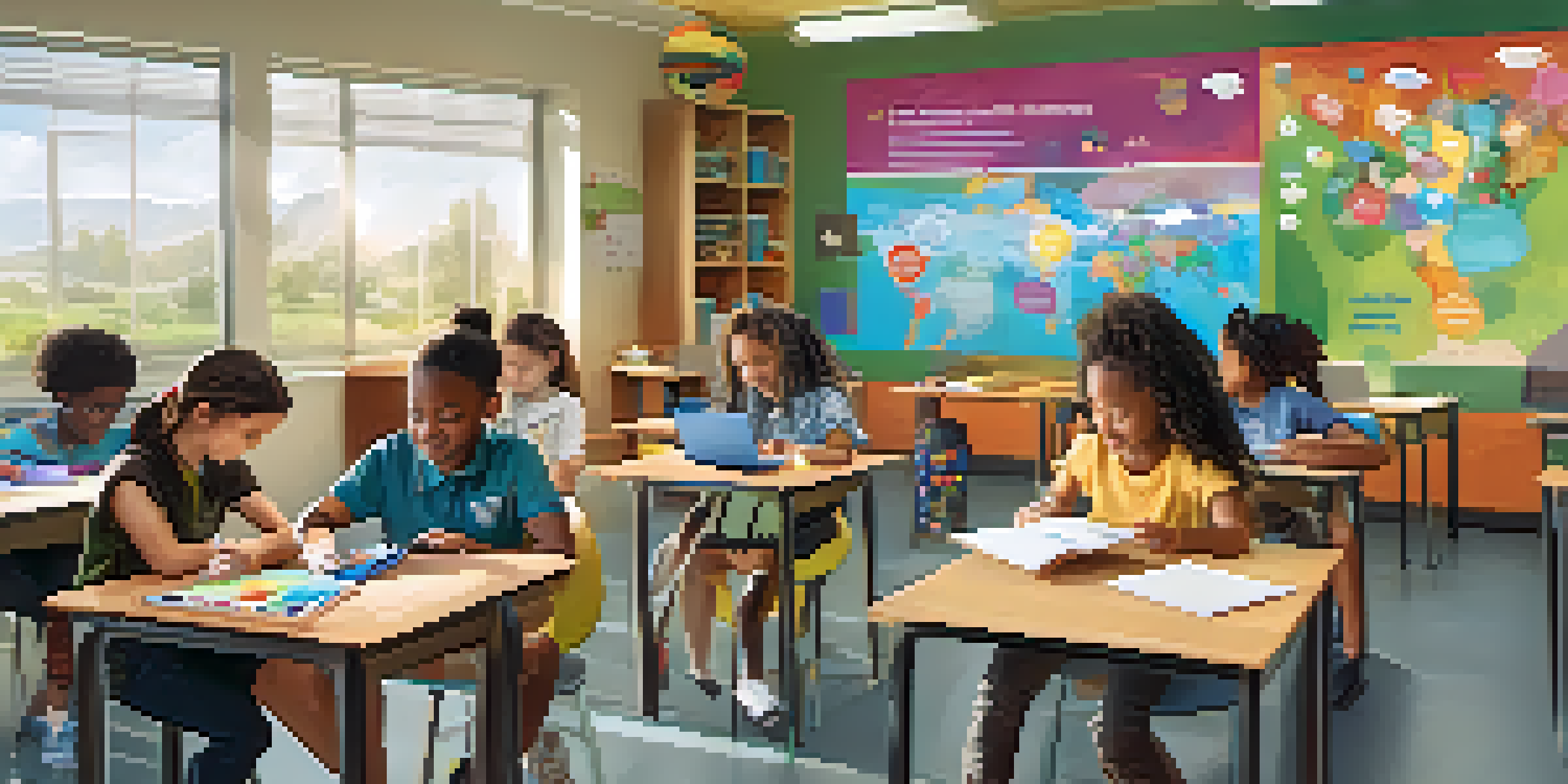Creating Inclusive Learning Environments with Technology

Understanding Inclusive Learning Environments
Inclusive learning environments are spaces where all learners feel valued and supported. They cater to diverse learning needs, ensuring that everyone, regardless of their background or abilities, can participate and thrive. This means acknowledging differences in learning styles, physical abilities, and cultural backgrounds while fostering a sense of belonging.
Inclusion is not a matter of political correctness. It is the key to growth.
An inclusive learning environment is not just about providing access; it's about creating experiences that engage every learner. For example, a classroom that incorporates various teaching methods—like visual aids, hands-on activities, and discussions—allows students to connect with the material in ways that resonate with them personally. This approach leads to deeper understanding and retention of knowledge.
Moreover, inclusivity goes beyond the physical space; it involves attitudes and practices that embrace diversity. Educators play a crucial role in modeling respect and empathy, encouraging students to appreciate different perspectives. When technology is integrated into this framework, it can significantly enhance the learning experience for all.
The Role of Technology in Education
Technology has transformed the landscape of education, providing tools that enhance learning experiences. From interactive whiteboards to online learning platforms, technology can address diverse needs and learning styles. For instance, students who struggle with reading can benefit from text-to-speech software, allowing them to engage with content they might otherwise find challenging.

Furthermore, technology offers a wealth of resources that promote inclusivity. Online courses and webinars provide opportunities for students who may not have access to traditional classrooms, such as those in remote areas or with disabilities. This democratization of education allows learners to pursue their interests and develop skills at their own pace.
Inclusive Learning Supports All
Inclusive learning environments value diverse backgrounds and abilities, ensuring every learner feels supported.
As we embrace technology in education, it's essential to ensure that these tools are accessible to all. This includes considering factors like internet connectivity, device availability, and user-friendly interfaces. By prioritizing accessibility, educators can ensure that technology serves as a bridge rather than a barrier.
Adaptive Learning Technologies Explained
Adaptive learning technologies personalize education by adjusting content and assessments based on individual student performance. This means that students receive tailored support that meets their unique needs, which can significantly enhance their learning experience. Think of it as having a personal tutor who knows exactly where you need help and provides the right resources at the right time.
Technology is best when it brings people together.
For example, platforms like DreamBox or Smart Sparrow adapt math problems based on how well a student is doing, allowing for immediate feedback and adjustment. This not only keeps learners engaged but also helps them progress at their own pace, reducing frustration and increasing confidence. Such technologies serve as powerful tools for educators aiming to create inclusive environments.
However, it's important to remember that while adaptive technologies can be incredibly beneficial, they should complement—not replace—traditional teaching methods. The human element of teaching, including relationships and emotional support, remains vital in fostering an inclusive atmosphere. Combining technology with compassionate teaching creates a holistic learning experience.
Collaboration Tools for Inclusive Learning
Collaboration tools play a significant role in creating inclusive learning environments by facilitating communication and teamwork among students. Tools like Google Classroom, Microsoft Teams, and Zoom allow learners to interact, share ideas, and work on projects together, regardless of their physical location. This can be especially beneficial for students who may feel isolated or struggle to engage in traditional classroom settings.
Using these tools, educators can create group assignments that encourage collaboration and peer learning. For instance, students can work together on a shared document, providing feedback and support to one another. This not only fosters a sense of community but also helps students develop valuable teamwork skills that are essential in today's workforce.
Technology Enhances Accessibility
Technology offers tools that address diverse learning needs, allowing for more engaging and inclusive educational experiences.
Moreover, collaboration tools often come with features that support diverse learners, such as screen sharing, voice-to-text capabilities, and translation services. By integrating these tools into everyday learning, educators can ensure that every student has a voice and an opportunity to contribute, thus enhancing inclusivity.
Gamification: Engaging All Learners
Gamification in education involves incorporating game-like elements into learning activities to motivate and engage students. This approach can be particularly effective in fostering inclusivity, as it appeals to a wide range of interests and learning styles. For example, students can earn points, badges, or rewards for completing tasks, which can encourage participation from even the most reluctant learners.
Platforms like Kahoot! and Quizizz allow educators to create interactive quizzes that not only make learning fun but also promote healthy competition and collaboration. By integrating gamified elements, teachers can capture students' attention and create a dynamic learning environment that caters to various abilities and preferences.
However, it's crucial to design gamified experiences thoughtfully. Consideration should be given to ensuring that all students can participate and succeed, regardless of their skill level. By creating varied challenges and allowing for different paths to success, gamification can enhance inclusivity and engagement in the classroom.
Assistive Technologies for Diverse Needs
Assistive technologies are tools designed to help individuals with disabilities overcome barriers to learning. These can range from simple adaptations, like pencil grips and audiobooks, to advanced software that enables communication for non-verbal students. By implementing these technologies, educators can create an environment where every learner has the opportunity to succeed.
For instance, speech recognition software can assist students with writing difficulties, allowing them to express their ideas without the constraints of traditional writing methods. Similarly, screen readers can help visually impaired students access digital content, ensuring they are not left behind in an increasingly digital world. These tools empower students to take charge of their learning experiences.
Collaboration and Gamification Matter
Collaboration tools and gamification strategies promote teamwork and motivation, further fostering inclusivity in learning.
It's essential for educators to stay informed about the latest assistive technologies and how they can be implemented in the classroom. Collaborating with special education professionals can provide valuable insights into selecting the right tools for diverse learners. Ultimately, the goal is to create a supportive environment where every student feels capable and included.
The Future of Inclusive Learning with Technology
As technology continues to evolve, so too does its potential to enhance inclusive learning environments. Innovations in artificial intelligence, virtual reality, and machine learning are paving the way for even more personalized and engaging educational experiences. For instance, virtual reality can create immersive learning opportunities that cater to various needs and preferences, allowing students to explore concepts in an interactive way.
Moreover, the shift towards hybrid and remote learning models has highlighted the importance of inclusivity in education. Educators are now more aware of the need to design lessons that accommodate different learning preferences and accessibility requirements. This focus on inclusivity will likely shape the development of future educational technologies, ensuring they are designed with all learners in mind.

Ultimately, the future of inclusive learning is bright, with technology serving as a powerful ally. By continuing to prioritize accessibility and inclusivity, educators can foster environments where every student has the opportunity to thrive, regardless of their background or abilities. Together, we can create a world where learning truly knows no boundaries.